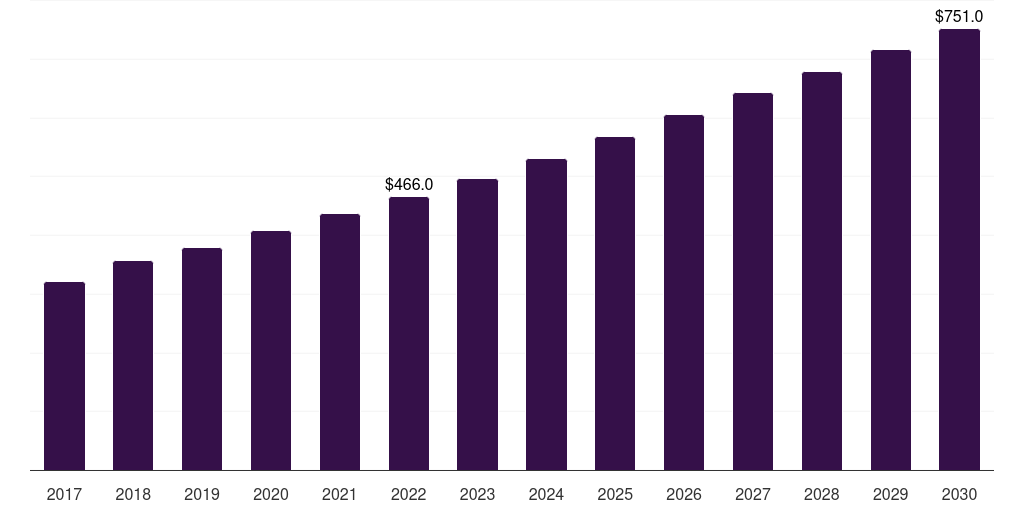North America Insect Repellent Market Size & Outlook
North America insect repellent market, 2017-2030 (US$M)

Related Markets
North America insect repellent market highlights
- The North America insect repellent market generated a revenue of USD 466.0 million in 2022.
- The market is expected to grow at a CAGR of 6.1% from 2023 to 2030.
- In terms of segment, mosquito repellent was the largest revenue generating insect type in 2022.
- Mosquito Repellent is the most lucrative insect type segment registering the fastest growth during the forecast period.
- Country-wise, Canada is expected to register the highest CAGR from 2023 to 2030.
North America data book summary
| Market revenue in 2022 | USD 466.0 million |
| Market revenue in 2030 | USD 751.0 million |
| Growth rate | 6.1% (CAGR from 2022 to 2030) |
| Largest segment | Mosquito repellent |
| Fastest growing segment | Mosquito Repellent |
| Historical data covered | 2017 - 2021 |
| Base year for estimation | 2022 |
| Forecast period covered | 2023 - 2030 |
| Quantitative units | Revenue in USD million |
| Market segmentation | Mosquito Repellent, Bugs Repellent, Fly Repellent |
| Key market players worldwide | Reckitt Benckiser Group PLC, Godrej, Dabur India, Johnson & Johnson, Spectrum Brands Holdings Inc, Henkel AG & Co KGaA, Jyothy Laboratories, Coghlan’s, SC Johnson, Sawyer Products |
Other key industry trends
- In terms of revenue, North America region accounted for 9.7% of the global insect repellent market in 2022.
- Globally, Asia Pacific is projected to lead the regional market in terms of revenue in 2030.
- Asia Pacific is the fastest growing regional market and is projected to reach USD 3,477.6 million by 2030.
Mosquito repellent was the largest segment with a revenue share of 47.6% in 2022. Horizon Databook has segmented the North America insect repellent market based on mosquito repellent, bugs repellent, fly repellent covering the revenue growth of each sub-segment from 2017 to 2030.
Climate change has considerably influenced the spread of diseases caused by pathogen-transmitting vectors, such as fleas, ticks, and mosquitoes. The Earth's rapid warming due to human-generated greenhouse gas emissions has significant and lasting consequences when it comes to controlling and preventing vector-borne diseases.
Furthermore, climate change has led to a shift in bird migration patterns and a decline in bird population in North America, impacting the transmission of the virus from Culex mosquitoes to humans. Currently, North America faces a heightened risk of various vector-borne diseases, such as dengue fever, Lyme disease, malaria, Rocky Mountain spotted fever, West Nile virus, plague, and tularemia.
This alarming scenario is likely to drive the regional market for insect repellents. According to an article by The New York Times, since April 2023, the Centers for Disease Control and Prevention has reported five cases of malaria infection in the U.S. four in Florida and one in Texas.
No credit card required*
Horizon in a snapshot
- 30K+ Global Market Reports
- 120K+ Country Reports
- 1.2M+ Market Statistics
- 200K+ Company Profiles
- Industry insights and more
Insect Repellent Market Scope
Insect Repellent Market Companies
| Name | Profile | # Employees | HQ | Website |
|---|
North America insect repellent market size, by country, 2017-2030 (US$M)
North America Insect Repellent Market Outlook Share, 2022 & 2030 (US$M)
Related regional statistics
Sign up - it's easy, and free!
Sign up and get instant basic access to databook, upgrade
when ready, or enjoy our
free plan indefinitely.
Included in Horizon account
- 30K+ Global Market Reports
- 120K+ Country Reports
- 1.2M+ Market Statistics
- 200K+ Company Profiles
- Industry insights and more


